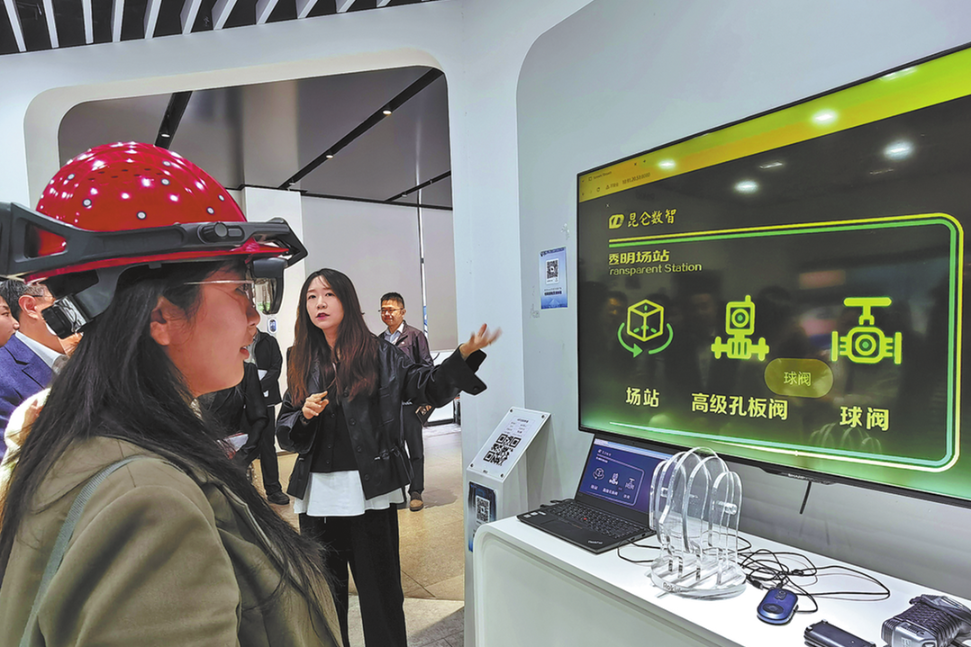Digitalization empowers China's cultural centers
Annual conference highlights the growing integration of technology into rural vitalization and how it boosts local learning and arts participation, Yang Feiyue reports.


At the digital exhibition hall of the China cultural centers' annual conference in Beijing in mid-November, a small crowd formed around a single illuminated desk.
They queued patiently for their turn at the desk, where they could practice Chinese calligraphy on the left side of the touchscreen while watching ink strokes unfurl on the right — each one appearing in perfect sync with what a teacher, standing a meter away, was writing.
The system projects a teacher's brush-strokes directly onto each learner's workspace. "It's like standing right next to the teacher," says Hou Jicen, from the Langfang public art center based in northern Hebei province.
Traditionally, calligraphy students watch the teacher from a distance, often hindered by viewing angles and limited class sizes. But the projection-based method places every stroke directly under the learner's hands, Hou explains.
The AI-assisted calligraphy experience has already transformed calligraphy education back in Langfang.
In the actual classroom, 30 such desks operate simultaneously, accommodating up to 40 learners at the same time, Hou says.
"Students can choose from different script styles — regular, clerical, running — within the same session," she adds.
Since its launch last year, the program has become the most popular offering in the center's public night education program.
"Registration usually fills within a day," Hou says, adding that demand is so high that classes are often doubled.
Young people make up the majority of the evening learners, while seniors attend daytime courses and children join weekend sessions.
The AI-supported classroom has expanded access and renewed enthusiasm for traditional arts. "It allows people with limited time to learn effectively and experience calligraphy up close," Hou says.
The calligraphy experience was among the highlights of the exhibition. Zhang Xuzhen, from the digital information department of the Zhejiang Provincial Cultural Center, says it presented the latest achievements of "AI plus public cultural services" from cultural centers nationwide.
"The idea was to bring together the projects that have already been implemented, especially those involving AI in public art education," Zhang explains.
His team collected examples from different provincial and municipal cultural centers, sorted them by technological function, and organized them into four thematic sections for the exhibition.
"Each section reflects a direction in which cultural centers are exploring the integration of AI," he explains.
The "AI plus smart services" demonstrates intelligent tools such as activity assistants, AI guides, teaching companions, and recommendation engines. The "AI plus aesthetic education" focuses on digitalized arts training and smart classrooms, while the "AI plus co-creation" opens cultural spaces to interactive, public participation. The last section, "AI plus cultural performance", presents new formats for immersive exhibition and stage shows.
Much of the content is supported by local databases, Zhang notes.
"Many of the projects are not simple stand-alone devices but interconnected systems that integrate regional cultural resources," he says.
"They can be used for exhibitions, introductions, guided tours, or whatever a cultural center needs, and is suitable for all age groups."
China's journey in digital public culture began in 2002 with the National Cultural Information Resources Sharing Project, followed by the construction of digital cultural centers in 2015.
Over two decades, services have evolved from simple digitalization to cloud-based access, and from online platforms to sophisticated hybrid models, Zhang emphasizes.
The exhibition was among the highlights of the 2025 China cultural centers' annual conference held in Beijing's Tongzhou district.
Hosted by the China Public Cultural Centers Association and the Tongzhou government, the two-day event gathered more than 2,500 experts, scholars, cultural center professionals, and industry representatives, with a focus on the high-quality development of cultural centers during the upcoming 15th Five-Year Plan (2026-30) period.
It showcased the joint efforts of Beijing, Tianjin, and Hebei, featured 14 thematic forums, nine major exhibitions, six public cultural performances, a procurement fair for public cultural products and services, and a resource-sharing program connecting national art troupes with grassroots communities.
Core topics covered the integration of AI into public arts education, the building of influential public cultural brands, the creation and dissemination of community-based artworks, and the strengthening of grassroots cultural talent.
Through keynote speeches, case demonstrations, and interactive exchanges, the conference showcased the latest achievements in the sector and explored new pathways for future development empowered by technology.
According to Jiao Yanjie, director of the information technology division at the National Center for Public Cultural Development under the Ministry of Culture and Tourism, this year marks a decade since the launch of the digital cultural centers initiative, introduced in 2015 to help local centers overcome staffing shortages and limited program capacity.
"Many cultural centers had only a handful of full-time art instructors, far fewer than the number of art categories they were expected to cover," Jiao says.
"Digital tools allowed us to expand coverage and enable more people to participate."
Livestreamed classes, online broadcasts of community performances, and hybrid programs have since become widely adopted.
Some virtual classes each attract over 100,000 viewers, far exceeding the few hundred seats available in most cultural center theaters, Jiao notes.
"The rise of online learning has also fueled the popularity of evening arts programs at many local cultural centers, which see registration slots snapped up within seconds," he says.
"Digitalization has significantly increased the cultural centers' participation and public recognition. As we enter the next stage, AI will play an even greater role in making arts education accessible to all," he adds.
Beyond digital innovation, provinces are also experimenting with new ways to bring culture directly into rural areas.
Xu Yan, deputy director of the Shandong Provincial Cultural Center, shares at the annual conference that the center has been following a long-standing provincial-municipal-county linkage model, initially used for cultural benefit campaigns that brought performances to rural and poverty-relief areas.
The mechanism matured significantly in 2023, when the province mobilized rapidly and delivered more than 700 events within a single week, including performances, training sessions, exhibitions, and forums. "This year, the number rose to more than 2,000 linked activities, benefiting over 2 million people in just one week," Xu notes.
The center has also engaged in small rural theater productions in Linyi city, where villagers and hobbyist writers submit scripts, which are reviewed by provincial and national-level playwrights. Selected writers refine their work under experts' guidance, after which productions move to filming or live staging. "It's truly by the people and for the people," Xu says.
"Villagers write, perform, and watch the plays — sometimes even in immersive formats where audiences and performers interact. These are incredibly popular," she adds.
Digital empowerment has also played a major role. Xu points to the Shandong urban-rural integrated cultural station information platform, which now includes over 90 percent of the province's cultural stations.
By 2025, Shandong had more than 1,800 township cultural stations, with 71.6 percent rated as high-quality. Through an "order-based" service model, premium provincial cultural resources have been delivered directly to grassroots stations. "These platforms help cultural influences reach a wider audience," Xu says.
She sees this annual conference as a new starting point for future work.
"We will continue to draw inspiration from real rural vitalization practices, tell the stories of our countryside, and use culture to inject lasting vitality into rural development," she says.
As digital tools continue to evolve, many cultural centers across China are exploring new ways to enrich their offerings and respond more effectively to public needs.
Conference participants agree that the aim is not to replace traditional cultural experiences but to make calligraphy, opera, crafts, reading, and community activities more accessible and engaging.




Today's Top News
- Death toll rises to 16 in Sydney's Bondi Beach shooting
- Firm stance on opening-up wins praise
- World looks to new engines for growth in 2026
- Evidence mounts of Japan's wartime atrocities
- Gunmen kill 11, wound many on Sydney beach
- Study finds Earth's deep water reservoirs






























